Atabak Dehban
HERB: Human-augmented Efficient Reinforcement learning for Bin-packing
Apr 23, 2025Abstract:Packing objects efficiently is a fundamental problem in logistics, warehouse automation, and robotics. While traditional packing solutions focus on geometric optimization, packing irregular, 3D objects presents significant challenges due to variations in shape and stability. Reinforcement Learning~(RL) has gained popularity in robotic packing tasks, but training purely from simulation can be inefficient and computationally expensive. In this work, we propose HERB, a human-augmented RL framework for packing irregular objects. We first leverage human demonstrations to learn the best sequence of objects to pack, incorporating latent factors such as space optimization, stability, and object relationships that are difficult to model explicitly. Next, we train a placement algorithm that uses visual information to determine the optimal object positioning inside a packing container. Our approach is validated through extensive performance evaluations, analyzing both packing efficiency and latency. Finally, we demonstrate the real-world feasibility of our method on a robotic system. Experimental results show that our method outperforms geometric and purely RL-based approaches by leveraging human intuition, improving both packing robustness and adaptability. This work highlights the potential of combining human expertise-driven RL to tackle complex real-world packing challenges in robotic systems.
AI-Powered Augmented Reality for Satellite Assembly, Integration and Test
Sep 26, 2024



Abstract:The integration of Artificial Intelligence (AI) and Augmented Reality (AR) is set to transform satellite Assembly, Integration, and Testing (AIT) processes by enhancing precision, minimizing human error, and improving operational efficiency in cleanroom environments. This paper presents a technical description of the European Space Agency's (ESA) project "AI for AR in Satellite AIT," which combines real-time computer vision and AR systems to assist technicians during satellite assembly. Leveraging Microsoft HoloLens 2 as the AR interface, the system delivers context-aware instructions and real-time feedback, tackling the complexities of object recognition and 6D pose estimation in AIT workflows. All AI models demonstrated over 70% accuracy, with the detection model exceeding 95% accuracy, indicating a high level of performance and reliability. A key contribution of this work lies in the effective use of synthetic data for training AI models in AR applications, addressing the significant challenges of obtaining real-world datasets in highly dynamic satellite environments, as well as the creation of the Segmented Anything Model for Automatic Labelling (SAMAL), which facilitates the automatic annotation of real data, achieving speeds up to 20 times faster than manual human annotation. The findings demonstrate the efficacy of AI-driven AR systems in automating critical satellite assembly tasks, setting a foundation for future innovations in the space industry.
3DSGrasp: 3D Shape-Completion for Robotic Grasp
Jan 02, 2023



Abstract:Real-world robotic grasping can be done robustly if a complete 3D Point Cloud Data (PCD) of an object is available. However, in practice, PCDs are often incomplete when objects are viewed from few and sparse viewpoints before the grasping action, leading to the generation of wrong or inaccurate grasp poses. We propose a novel grasping strategy, named 3DSGrasp, that predicts the missing geometry from the partial PCD to produce reliable grasp poses. Our proposed PCD completion network is a Transformer-based encoder-decoder network with an Offset-Attention layer. Our network is inherently invariant to the object pose and point's permutation, which generates PCDs that are geometrically consistent and completed properly. Experiments on a wide range of partial PCD show that 3DSGrasp outperforms the best state-of-the-art method on PCD completion tasks and largely improves the grasping success rate in real-world scenarios. The code and dataset will be made available upon acceptance.
Robotic Learning the Sequence of Packing Irregular Objects from Human Demonstrations
Oct 04, 2022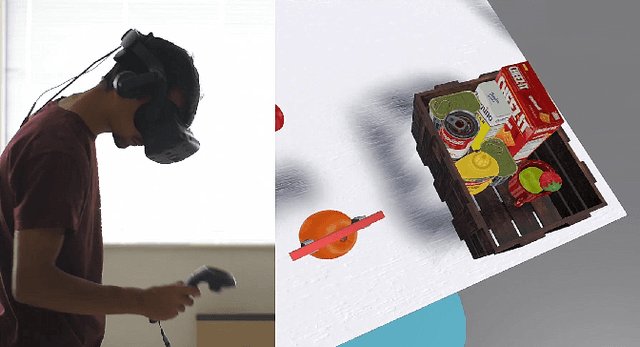
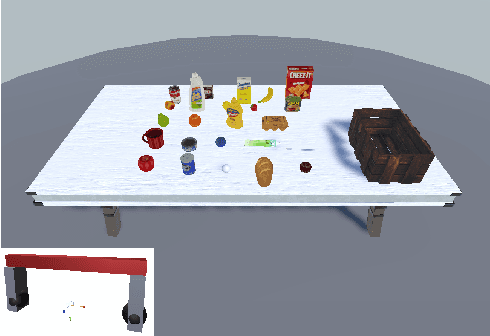
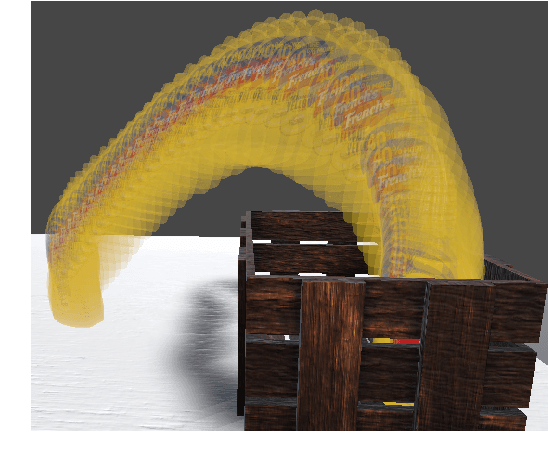
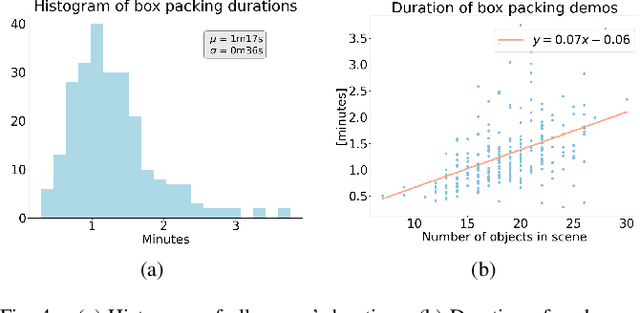
Abstract:We address the unsolved task of robotic bin packing with irregular objects, such as groceries, where the underlying constraints on object placement and manipulation, and the diverse objects' physical properties make preprogrammed strategies unfeasible. Our approach is to learn directly from expert demonstrations in order to extract implicit task knowledge and strategies to achieve an efficient space usage, safe object positioning and to generate human-like behaviors that enhance human-robot trust. We collect and make available a novel and diverse dataset, BoxED, of box packing demonstrations by humans in virtual reality. In total, 263 boxes were packed with supermarket-like objects by 43 participants, yielding 4644 object manipulations. We use the BoxED dataset to learn a Markov chain to predict the object packing sequence for a given set of objects and compare it with human performance. Our experimental results show that the model surpasses human performance by generating sequence predictions that humans classify as human-like more frequently than human-generated sequences.
SENSORIMOTOR GRAPH: Action-Conditioned Graph Neural Network for Learning Robotic Soft Hand Dynamics
Jul 18, 2021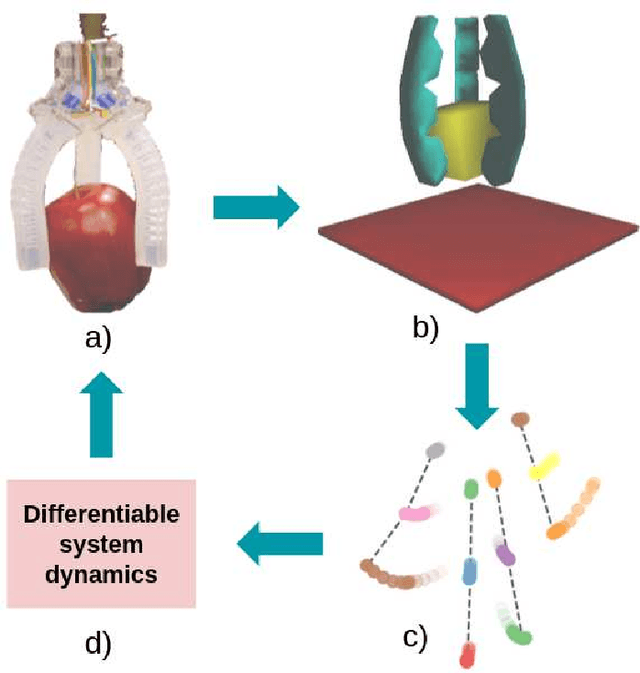
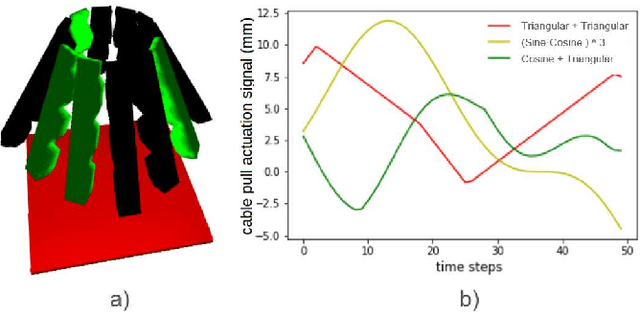
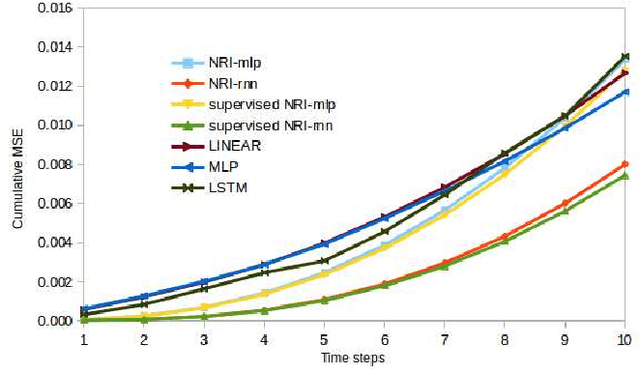
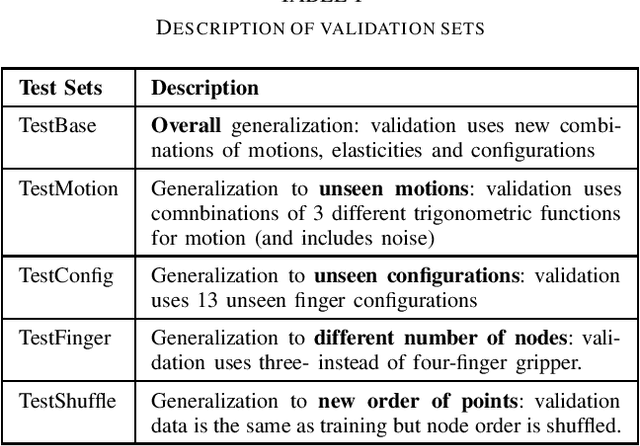
Abstract:Soft robotics is a thriving branch of robotics which takes inspiration from nature and uses affordable flexible materials to design adaptable non-rigid robots. However, their flexible behavior makes these robots hard to model, which is essential for a precise actuation and for optimal control. For system modelling, learning-based approaches have demonstrated good results, yet they fail to consider the physical structure underlying the system as an inductive prior. In this work, we take inspiration from sensorimotor learning, and apply a Graph Neural Network to the problem of modelling a non-rigid kinematic chain (i.e. a robotic soft hand) taking advantage of two key properties: 1) the system is compositional, that is, it is composed of simple interacting parts connected by edges, 2) it is order invariant, i.e. only the structure of the system is relevant for predicting future trajectories. We denote our model as the 'Sensorimotor Graph' since it learns the system connectivity from observation and uses it for dynamics prediction. We validate our model in different scenarios and show that it outperforms the non-structured baselines in dynamics prediction while being more robust to configurational variations, tracking errors or node failures.
Action-conditioned Benchmarking of Robotic Video Prediction Models: a Comparative Study
Oct 07, 2019



Abstract:A defining characteristic of intelligent systems is the ability to make action decisions based on the anticipated outcomes. Video prediction systems have been demonstrated as a solution for predicting how the future will unfold visually, and thus, many models have been proposed that are capable of predicting future frames based on a history of observed frames~(and sometimes robot actions). However, a comprehensive method for determining the fitness of different video prediction models at guiding the selection of actions is yet to be developed. Current metrics assess video prediction models based on human perception of frame quality. In contrast, we argue that if these systems are to be used to guide action, necessarily, the actions the robot performs should be encoded in the predicted frames. In this paper, we are proposing a new metric to compare different video prediction models based on this argument. More specifically, we propose an action inference system and quantitatively rank different models based on how well we can infer the robot actions from the predicted frames. Our extensive experiments show that models with high perceptual scores can perform poorly in the proposed action inference tests and thus, may not be suitable options to be used in robot planning systems.
Automatic generation of object shapes with desired functionalities
Oct 16, 2018



Abstract:3D objects (artefacts) are made to fulfill functions. Designing an object often starts with defining a list of functionalities that it should provide, also known as functional requirements. Today, the design of 3D object models is still a slow and largely artisanal activity, with few Computer-Aided Design (CAD) tools existing to aid the exploration of the design solution space. To accelerate the design process, we introduce an algorithm for generating object shapes with desired functionalities. Following the concept of form follows function, we assume that existing object shapes were rationally chosen to provide desired functionalities. First, we use an artificial neural network to learn a function-to-form mapping by analysing a dataset of objects labeled with their functionalities. Then, we combine forms providing one or more desired functions, generating an object shape that is expected to provide all of them. Finally, we verify in simulation whether the generated object possesses the desired functionalities, by defining and executing functionality tests on it.
Applying Domain Randomization to Synthetic Data for Object Category Detection
Jul 16, 2018



Abstract:Recent advances in deep learning-based object detection techniques have revolutionized their applicability in several fields. However, since these methods rely on unwieldy and large amounts of data, a common practice is to download models pre-trained on standard datasets and fine-tune them for specific application domains with a small set of domain relevant images. In this work, we show that using synthetic datasets that are not necessarily photo-realistic can be a better alternative to simply fine-tune pre-trained networks. Specifically, our results show an impressive 25% improvement in the mAP metric over a fine-tuning baseline when only about 200 labelled images are available to train. Finally, an ablation study of our results is presented to delineate the individual contribution of different components in the randomization pipeline.
Learning at the Ends: From Hand to Tool Affordances in Humanoid Robots
Apr 09, 2018



Abstract:One of the open challenges in designing robots that operate successfully in the unpredictable human environment is how to make them able to predict what actions they can perform on objects, and what their effects will be, i.e., the ability to perceive object affordances. Since modeling all the possible world interactions is unfeasible, learning from experience is required, posing the challenge of collecting a large amount of experiences (i.e., training data). Typically, a manipulative robot operates on external objects by using its own hands (or similar end-effectors), but in some cases the use of tools may be desirable, nevertheless, it is reasonable to assume that while a robot can collect many sensorimotor experiences using its own hands, this cannot happen for all possible human-made tools. Therefore, in this paper we investigate the developmental transition from hand to tool affordances: what sensorimotor skills that a robot has acquired with its bare hands can be employed for tool use? By employing a visual and motor imagination mechanism to represent different hand postures compactly, we propose a probabilistic model to learn hand affordances, and we show how this model can generalize to estimate the affordances of previously unseen tools, ultimately supporting planning, decision-making and tool selection tasks in humanoid robots. We present experimental results with the iCub humanoid robot, and we publicly release the collected sensorimotor data in the form of a hand posture affordances dataset.
 Add to Chrome
Add to Chrome Add to Firefox
Add to Firefox Add to Edge
Add to Edge